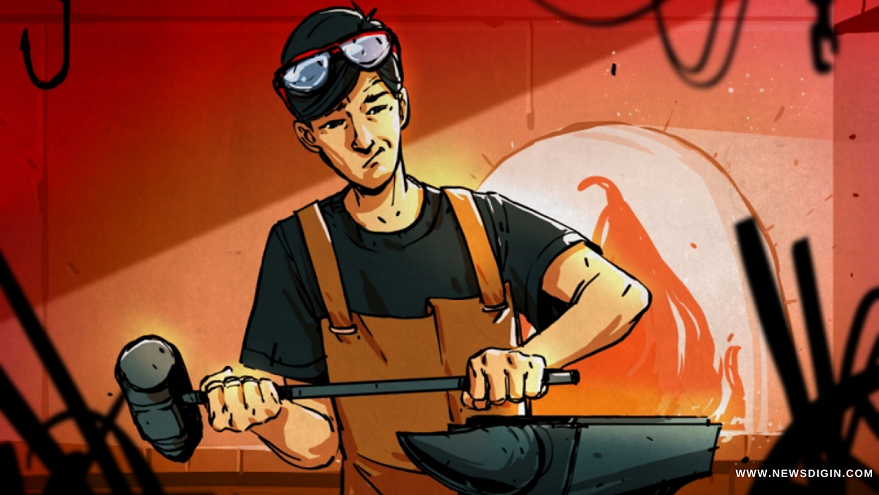
Blacksmith Hammering, Never Done Blacksmithing First Visit To Anvil: The Blacksmithing For The Uninitiated series, which we’ve been running for the past few months, examines the craft of forge work from the perspective of a novice.
It’s based on my personal experience as a child growing up in a working blacksmith’s shop and becoming a passionate but inexperienced blacksmith.
So far, we’ve focused on the tools you’d need to get started with blacksmithing on your own. Assuming we’ve already built a simple forge, it’s time to light it up and start hammering away at the anvil.
It’s simple to start a forge. A gas torch is one option, but I like to break firewood into sticks by hand, then use the hammer’s fuller in the anvil’s tough hole as a makeshift splitter.
I ignite the blower and pile coke on top of the resultant blaze after lighting some paper under my mound of sticks on the fireplace adjacent to the tuyere.
It will take around 10 minutes for fire to reach its full roaring potential and a stack of flaming coals will form at the bottom of the fire, which I will have to rake once the coals have finished burning.
Blacksmith Hammering, Never Done Blacksmithing First Visit To Anvil

CONSIDER WHAT KIND OF STEEL YOU USE
You can use a square or round 10 mm (3/8′′) piece of steel for your first experiment; it doesn’t matter if it’s square or round.
I’d recommend one that’s at least 300 mm (1′) long so you don’t have to use tongs to hold the cool end.
You’ll no sure experiment with a wide range of materials to see what works best for you based on what comes your way.
The more harder the steel is to work, the greater the stock quality is for experimenting.
STRIKE ONE OF THE HAMMER AND YOU’RE IN
If you have a piece of 10 mm yellow-hot steel with a 25 mm cold end, you can place it on the anvil’s face by holding it by the cold end.
To get it to spread out, continuously hammer the hot end in the same location. This isn’t a project; it’s really a warm-up for working with metal and the hammering motion.
The traditional picture of a blacksmith is to raise the hammer high for each stroke, but you want to use it in a rhythmic manner in your lower arm and wrist, taking advantage of the rebound we discussed when discussing what makes a good anvil.
As you pound, you’ll notice that the piece loses heat, going from yellow to orange to red, and finally to a dull red with hints of grey.
To get it back up to temperature, simply place it back in the coals and go through the process all over again.
GOING FROM ROUND TO SQUARE, OR THE OTHER WAY AROUND
Once you have a basic understanding of metal, you should move on to something more helpful. Take the other end of your flattened stock and heat it in the embers for about 50 mm (2 inches) as previously.
If the stock is square, you’ll round it up, and if it’s round, you’ll square it down. Then, using a hammer evenly distributed along its length, strike it until it breaks.
If you keep going, you’ll get a longer, flattened piece of metal, but this time you’ll be turning the stock as you strike the hammer.
WHERE DO I START?
Finally, you’ll finish off your newly squared or rounded stock by adding a point today. Place the 25 mm end on the anvil’s face at a 20-degree angle and heat it up.
As you slowly rotate the hammer, keep it at an angle to the extreme end so that a point forms.
With each hammering back and forth, the effect will grow stronger. No matter, how much work one is putting in, you’ll never be able to achieve pencil-like sharpness.
You should now have a piece of stock with a flat end that looks like a leaf and a point on the other end. Even if you haven’t manufactured anything useful yet, you have mastered the fundamentals of blacksmithing nonetheless.
Next week, we’ll try our hand at bending steel to create curves, loops, and scrolls. This series will continue with more fundamental blacksmithing methods.
Despite the fact that I grew up around professional blacksmiths, I am not one myself. However, as time goes on, you should acquire a foundation of basic skills upon which you can improve your capacity to create more intricate pieces of work.
Also Read: